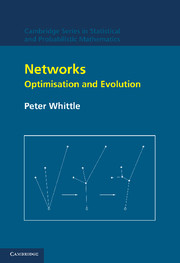Book contents
- Frontmatter
- Contents
- Acknowledgements
- Conventions on notation
- Tour d'Horizon
- Part I Distributional networks
- 1 Simple flows
- 2 Continuum formulations
- 3 Multi-commodity and destination-specific flows
- 4 Variable loading
- 5 Concave costs and hierarchical structure
- 6 Road networks
- 7 Structural optimisation: Michell structures
- 8 Computational experience of evolutionary algorithms
- 9 Structure design for variable load
- Part II Artificial neural networks
- Part III Processing networks
- Part IV Communication networks
- Appendix 1 Spatial integrals for the telephone problem
- Appendix 2 Bandit and tax processes
- Appendix 3 Random graphs and polymer models
- References
- Index
8 - Computational experience of evolutionary algorithms
Published online by Cambridge University Press: 23 November 2009
- Frontmatter
- Contents
- Acknowledgements
- Conventions on notation
- Tour d'Horizon
- Part I Distributional networks
- 1 Simple flows
- 2 Continuum formulations
- 3 Multi-commodity and destination-specific flows
- 4 Variable loading
- 5 Concave costs and hierarchical structure
- 6 Road networks
- 7 Structural optimisation: Michell structures
- 8 Computational experience of evolutionary algorithms
- 9 Structure design for variable load
- Part II Artificial neural networks
- Part III Processing networks
- Part IV Communication networks
- Appendix 1 Spatial integrals for the telephone problem
- Appendix 2 Bandit and tax processes
- Appendix 3 Random graphs and polymer models
- References
- Index
Summary
The subject of structural design is of course a long-established and sophisticated one, with an enormous literature. Explicit optimisation was however long regarded as too ambitious a target, whose attempt would entrain risky over-simplifications and the neglect of the wealth of intuition gained by practical experience. However, the advent of powerful computers has made the ambition a realisable one, and revived interest in the class of ideas revealed by Michell.
These developments have now generated a substantial literature in their turn; see Section 8.4 for references. We shall draw particularly, however, on the recent text by Bendsøe and Sigmund (2003). These authors have cast the optimality equations into a form suitable for efficient computation, and have acquired a vast computational experience on a range of practical problems, many of them highly sophisticated, to the point that their programmes virtually deliver production-ready working drawings. In many respects their work may be said to lead theoretical insight rather than follow it.
We refer to the Bendsøe–Sigmund text often enough that it is convenient to use the abbreviation BS. The text by Xie and Stevens (1997) uses somewhat different techniques, and so supplies interesting comparisons; we shall refer to it as XS.
Solid materials
BS consider largely the case of a linear, elastic medium (so that α = β = 2 and the medium follows the same linear Hooke's law in tension and in compression). Terms like ‘work’ and ‘strain energy’ then have their conventional mechanical interpretations.
- Type
- Chapter
- Information
- NetworksOptimisation and Evolution, pp. 116 - 125Publisher: Cambridge University PressPrint publication year: 2007

